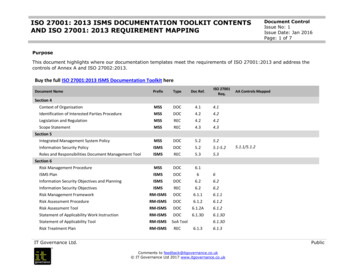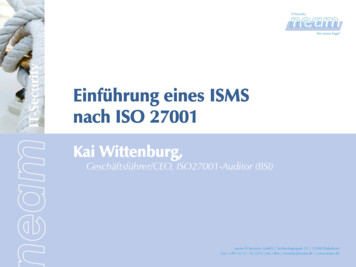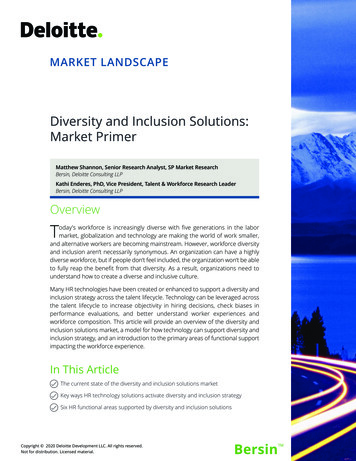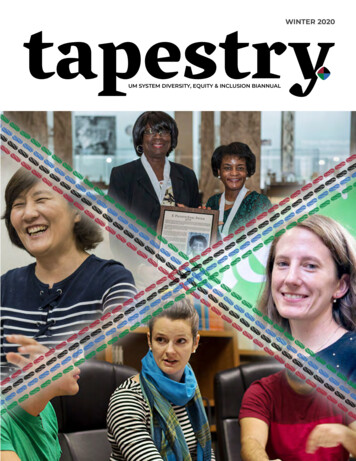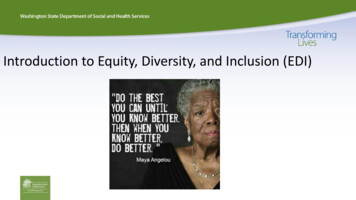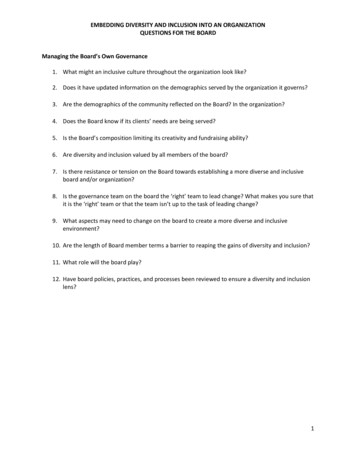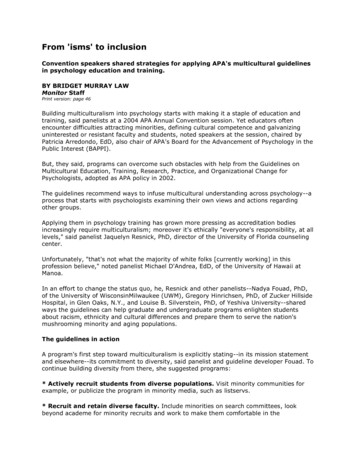
Transcription
From 'isms' to inclusionConvention speakers shared strategies for applying APA's multicultural guidelinesin psychology education and training.BY BRIDGET MURRAY LAWMonitor StaffPrint version: page 46Building multiculturalism into psychology starts with making it a staple of education andtraining, said panelists at a 2004 APA Annual Convention session. Yet educators oftenencounter difficulties attracting minorities, defining cultural competence and galvanizinguninterested or resistant faculty and students, noted speakers at the session, chaired byPatricia Arredondo, EdD, also chair of APA's Board for the Advancement of Psychology in thePublic Interest (BAPPI).But, they said, programs can overcome such obstacles with help from the Guidelines onMulticultural Education, Training, Research, Practice, and Organizational Change forPsychologists, adopted as APA policy in 2002.The guidelines recommend ways to infuse multicultural understanding across psychology--aprocess that starts with psychologists examining their own views and actions regardingother groups.Applying them in psychology training has grown more pressing as accreditation bodiesincreasingly require multiculturalism; moreover it's ethically "everyone's responsibility, at alllevels," said panelist Jaquelyn Resnick, PhD, director of the University of Florida counselingcenter.Unfortunately, "that's not what the majority of white folks [currently working] in thisprofession believe," noted panelist Michael D'Andrea, EdD, of the University of Hawaii atManoa.In an effort to change the status quo, he, Resnick and other panelists--Nadya Fouad, PhD,of the University of WisconsinMilwaukee (UWM), Gregory Hinrichsen, PhD, of Zucker HillsideHospital, in Glen Oaks, N.Y., and Louise B. Silverstein, PhD, of Yeshiva University--sharedways the guidelines can help graduate and undergraduate programs enlighten studentsabout racism, ethnicity and cultural differences and prepare them to serve the nation'smushrooming minority and aging populations.The guidelines in actionA program's first step toward multiculturalism is explicitly stating--in its mission statementand elsewhere--its commitment to diversity, said panelist and guideline developer Fouad. Tocontinue building diversity from there, she suggested programs:* Actively recruit students from diverse populations. Visit minority communities forexample, or publicize the program in minority media, such as listservs.* Recruit and retain diverse faculty. Include minorities on search committees, lookbeyond academe for minority recruits and work to make them comfortable in the
department.* Examine all courses for multicultural infusion. "Audit" a range of courses formulticultural content.* Evaluate students regularly for multicultural learning. Test students on diversityknowledge and weigh it when grading papers and other assignments. Survey students oncourse inclusion of multicultural content.* Ensure multiculturalism in clinical training. Expose students to clinical work withdiverse populations and evaluate them on multicultural competence. UWM's program, forexample, requires a practicum in a multicultural, urban setting.Diversity challengesTaking such steps has significantly bolstered UWM's adherence to the multiculturalguidelines, said Fouad. For example, its faculty study a range of diversity issues, fromdisabilities to women to sexual orientation to race and ethnicity. Yet, she said, the programfaces ongoing challenges in the areas of:* Student and faculty recruiting. Faculty continue to be mostly white and male, andstudents are mostly white too.* Minority-focused coursework. While race and culture are infused throughout thecurriculum, faculty still seek a dedicated course to address racial identity and racism.* Student competency evaluation. Formal evaluations mostly don't consider studentimpairment in work with multicultural groups.* Supervisor competence evaluation. The program lacks evaluation of supervisors onmulticultural competence.Fellow panelist Resnick advised programs to tackle such challenges head on. Lead byexample, she suggested, consider power-structure shifts, encourage group cooperation andset goals for diversifying your program. "But be patient," said Resnick. "No one gives upprivilege willingly or with ease."Resnick also recommended programs evaluate their own progress and hire multiculturalconsultants to gain an outside perspective.Most importantly, she advised, realize that multicultural infusion is ongoing. "This is notsomething you get to do in a workshop or in a week or even in a year," she explained. "Itrequires continuous attention and awareness-raising."For a copy of APA's multicultural guidelines, go to www.apa.org/pi/multiculturalguidelines orread the May American Psychologist (Vol. 58, No. 5).
Guidelines on Multicultural Education, Training, Research, Practice, andOrganizational Change for PsychologistsAmerican Psychological AssociationApproved as APA Policy by the APA Council of Representatives, August, 2002Author Note:This document was approved as policy of the American Psychological Association (APA) bythe APA Council of Representatives in August, 2002. This document was drafted by a jointTask Force of APA Divisions 17 (Counseling Psychology) and 45 (The Society for thePsychological Study of Ethnic Minority Issues). These guidelines have been in the process ofdevelopment for 22 years, so many individuals and groups require acknowledgement. TheDivisions 17/45 writing team for the present document included Nadya Fouad, PhD, Co–Chair, Patricia Arredondo, EdD, Co–Chair, Michael D'Andrea, EdD and Allen Ivey, EdD. Theseguidelines build on work related to multicultural counseling competencies by Division 17(Sue et al., 1982) and the Association of Multicultural Counseling and Development(Arredondo et al., 1996; Sue, Arredondo, & McDavis, 1992). The Task Force acknowledgesAllen Ivey, EdD, Thomas Parham, PhD, and Derald Wing Sue, PhD for their leadershiprelated to the work on competencies. The Divisions 17/45 writing team for these guidelineswas assisted in reviewing the relevant literature by Rod Goodyear, PhD, Jeffrey S. Mio, PhD,Ruperto (Toti) Perez, PhD, William Parham, PhD, and Derald Wing Sue, PhD. Additionalwriting contributions came from Gail Hackett, PhD, Jeanne Manese, PhD, Louise Douce,PhD, James Croteau, PhD, Janet Helms, PhD, Sally Horwatt, PhD, Kathleen Boggs, PhD,Gerald Stone, PhD, and Kathleen Bieschke, PhD. Editorial contributions were provided byNancy Downing Hansen, PhD, Patricia Perez, Tiffany Rice, and Dan Rosen. The Task Force isgrateful for the active support and contributions of a series of presidents of APA Divisions17, 35, and 45, including Rosie Bingham, PhD, Jean Carter, PhD, Lisa Porche Burke, PhD,Gerald Stone, PhD, Joseph Trimble, PhD, Melba Vasquez, PhD, and Jan Yoder, PhD. Otherindividuals who contributed through their advocacy include Guillermo Bernal, PhD, RobertCarter, PhD, J. Manuel Casas, PhD, Don Pope–Davis, PhD, Linda Forrest, PhD, MargaretJensen, PhD, Teresa LaFromboise, PhD, Joseph G. Ponterotto, PhD, and Ena VazquezNuttall, EdD.The final version of this document was strongly influenced by the contributions of a workinggroup jointly convened by the APA Board for the Advancement of Psychology in the PublicInterest (BAPPI) and the APA Board of Professional Affairs (BPA). In addition to Nadya
Fouad, PhD and Patricia Arredondo, EdD from the Divisions 17/45 Task Force, members ofthe working group included Maria Root, PhD, BAPPI (Working Group Co–Chair), Sandra L.Shullman, PhD, BPA (Working Group Co– Chair), Toy Caldwell–Colbert, PhD, APA Board ofEducational Affairs, Jessica Henderson Daniels, PhD, APA Committee for the Advancement ofProfessional Practice, Janet Swim, PhD, representing the APA Board of Scientific Affairs,Kristin Hancock, PhD, BPA Committee on Professional Practice and Standards, and LauraBarbanel, PhD, APA Board of Directors. This working group was assisted in its efforts by APAstaff members Shirlene A. Archer, JD, Public Interest Directorate, and Geoffrey M. Reed,PhD, Practice Directorate, who also jointly shepherded the document through the finalapproval process. The Task Force also acknowledges APA staff members Paul Donnelly,Alberto Figueroa, Bertha Holliday, PhD, Sarah Jordan, Joan White and Henry Tomes, PhD fortheir support. Correspondence concerning this article should be directed to the PublicInterest Directorate, American Psychological Association, 750 First Street, NE, Washington,DC 20002–4242. This document is scheduled to expire as APA policy by 2009. After thisdate, users are encouraged to contact the APA Public Interest Directorate to confirm thestatus of the document.Guidelines on Multicultural Education, Training, Research, Practice, andOrganizational Change for PsychologistsAll individuals exist in social, political, historical, and economic contexts, and psychologistsare increasingly called upon to understand the influence of these contexts on individuals'behavior. The Guidelines on Multicultural Education, Training, Research, Practice, andOrganizational Change for Psychologists reflect the continuing evolution of the study ofpsychology, changes in society–at–large, and emerging data about the different needs forparticular individuals and groups historically marginalized or disenfranchised within and bypsychology based on their ethnic/racial heritage and social group identity or membership.These Guidelines on Multicultural Education, Training, Research, Practice, andOrganizational Change reflect knowledge and skills needed for the profession in the midst ofdramatic historic sociopolitical changes in U.S. society, as well as needs from newconstituencies, markets, and clients.The specific goals of these Guidelines are to provide psychologists with: (a) the rationaleand needs for addressing multiculturalism and diversity in education, training, research,practice, and organizational change; (b) basic information, relevant terminology, currentempirical research from psychology and related disciplines, and other data that support the
proposed guidelines and underscore their importance; (c) references to enhance on–goingeducation, training, research, practice, and organizational change methodologies; and (d)paradigms that broaden the purview of psychology as a profession.In these Guidelines, education refers to the psychological education of students in all areasof psychology, while training refers more specifically to the application of that education tothe development of applied and research skills. We refer to research that involves humanparticipants, rather than research using animals or mathematical simulations. Practice refersto interventions with children, adolescents, adults, families, and organizations, typicallyconducted by clinical, consulting, counseling, organizational, and school psychologists.Finally, we focus on the work of psychologists as administrators, consultants, and in otherorganizational management roles positioned to promote organizational change and policydevelopment.These Guidelines address U.S. ethnic and racial minority1 groups as well as individuals,children, and families from biracial, multiethnic, and multiracial backgrounds. Thus, we aredefining "multicultural" in these Guidelines narrowly, to refer to interactions betweenindividuals from minority ethnic and racial groups in the United States and the dominantEuropean–American culture. Ethnic and racial minority group membership includesindividuals of Asian and Pacific Islander, Sub–Saharan Black African, Latino/Hispanic, andNative American/American Indian descent, although there is great heterogeneity withineach of these groups. The Guidelines also address psychologists' work and interactions withindividuals from other nations, including international students and immigrants andtemporary workers in this country.The term "guidelines" refers to pronouncements, statements or declarations that suggest orrecommend specific professional behavior, endeavors or conduct for psychologists (APA,1992). Guidelines differ from standards in that standards are mandatory and may beaccompanied by an enforcement mechanism (APA, 2001). Theyare intended to facilitate the continued systematic development of the profession and tohelp assure a high level of professional practice by psychologists. Guidelines are notintended to be mandatory or exhaustive and may not be applicable to every professionaland clinical situation. They are not definitive and they are not intended to take precedenceover the judgment of psychologists. In addition, federal or state laws may supercede theseGuidelines.
Scope of GuidelinesThis document is comprehensive but not exhaustive. We intend to reflect the context andrationale for these Guidelines in multiple settings and situations, but also acknowledge thatwe expect the document to evolve over time with more illustrative examples andreferences. In the current document we will initially provide evidence for the need formulticultural guidelines with an overview of the most recent demographic data onracial/ethnic diversity in the United States, and the representation of racial/ethnic minoritiesin education and psychology. We then discuss the social and political developments in theUnited States and the profession of psychology that provide a context for the developmentof the Guidelines, and the fundamental principles on which we base the Guidelines. EachGuideline is then presented, with the first two Guidelines designed to apply to allpsychologists from two primary perspectives: (a) knowledge of self with a cultural heritageand varying social identities; and (b) knowledge of other cultures. Guidelines # 3–6 addressthe application of multiculturalism in education, training, research, practice, andorganizational change.While these Guidelines have attempted to incorporate empirical studies of intergrouprelations and ethnic identity, professional consensus, and other perceptions and experiencesof ethnic and racial minority groups, it is beyond the scope of this document to provide athorough and comprehensive review of all literature related to race, ethnicity, intergroupprocesses, and organizational development strategies to address multiculturalism inemployment and professional education contexts. Rather, we have attempted to provideexamples of empirical and conceptual literature relevant to the Guidelines where possible.Racial/ethnic Diversity in the United States and PsychologyIndividuals of ethnic and racial minority and/or with a biracial/multiethnic/multiracialheritage represent an increasingly large percentage of the population in the United States(Judy & D'Amico, 1997; United States Census Bureau, 2001; Wehrly, Kenney, & Kenney,1999). While these demographic trends have been discussed since the previous census of1990, educational institutions, employers, government agencies, and professional andaccrediting bodies are now beginning to engage in systematic efforts to become moreknowledgeable, proficient, and multiculturally responsive. Census 2000 data clarify thechanges in U.S. diversity (U.S. Census Bureau, 2001). Overall, about 67% of the populationidentify as White. Of the remaining 33%, approximately 13% indicated they were AfricanAmerican, 1.5% American Indian or Alaskan Native, 4.5% Asian/Pacific Islander, 13%
Hispanic, and about 7% indicated some other race. These categories overlap, sinceindividuals were able to choose more than one racial affiliation. Racial/ethnic diversity variesgreatly by state. Summarized in a series of maps by Brewer and Suchan from the Census2000 data (2001), high diversity states (those with 60–77% racial/ethnic minority groups)tend to be on the coast, or Mexican border and include California, Texas, Arizona, NewMexico, and Virginia. In addition to these, however, medium–high diversity (49%–59%racial/ethnic minority groups) states are found across the country, and include Maryland,New York, Illinois, Washington State, Nevada, Colorado, Montana, Alaska, North Dakota,South Dakota, Minnesota, Wisconsin, Michigan, Arkansas, Louisiana, Alabama, and Northand South Carolina.In the past 10 years, percentage–wise, the greatest increases are reported for AsianAmerican/Pacific Islanders and Latinos/Hispanics, and in some parts of the country, WhiteEuropean Americans are no longer a clear majority of the population. Brewer and Suchan(2001) found that diversity increased in all states in the country, and in parts of somestates increased as much as 34%. States that had the most growth in diversity variedgeographically, including the Midwest (Nebraska, Iowa, Kansas, Eastern Colorado), South(Georgia, Florida, Texas, and Oklahoma), and Northwest (Idaho, Oregon). In addition, forthe first time, Census 2000 allowed individuals to check more than one racial/ethnicaffiliation (U.S. Census Bureau, 2001). While only 2.4% of the U.S. populations checkedmore than one racial affiliation, 42% of those who checked two or more races were under18, indicating an increase in the birthrate of biracial individuals. Certainly, the United Statesis becoming more racially and ethnically diverse, increasing the urgency for culturallyresponsive practices and services.Ethnic, racial, and multiracial diversity in the population is reflected in higher education.This is important to psychologists because it reflects changes in the ethnic composition ofstudents we teach and train. College enrollment increased 62% for students of colorbetween 1988 and 1998 (the latest data available), although college completion ratesdiffered among Whites and racial/ethnic minority students. College completion rates in 2000(U.S. Census Bureau, 2001) for White individuals between 25– 29 years was 29.6%,compared to 17.8% for African Americans, 53.9% for Asian/Pacific Islander Americans, and9.7% for Hispanics. Corresponding statistics in 1991 vs. 1974, were 24.6% vs. 22% forWhites, 11% vs. 7.9% for African Americans/Blacks, and 9.2% vs. 5.7% for Hispanics. Datafor Hispanics were first collected in 1974; data for Asian/Pacific Islanders were not collecteduntil the mid–90's. Clearly these data indicate that racial/ethnic minority students are
graduating at a lower rate than White students, but the data also show that they aremaking educational gains.Completion of a psychology degree is particularly germane to these Guidelines, sinceobtaining a college degree is the first step in the pipeline to becoming a psychologist. TheNational Center on Educational Statistics collects information on degrees conferred by area,reported by race/ethnicity. Their latest report (NCES, 2001) indicates that 74,060 bachelor'sdegrees were awarded in psychology last year, 14,465 master's degrees were awarded inpsychology, and 4310 doctoral degrees were awarded in psychology. Of those degrees, themajority was awarded to Whites (72% of Bachelor's and master's degrees and 77% ofdoctoral degrees). African Americans received 10% of both bachelor's and master's degreesand 5% of doctoral degrees, Hispanics received 10% of bachelor's degrees and 5% of bothmaster's and doctoral degrees, Asian/Pacific Islanders received 6% of bachelor's degrees,3% of master's, and 4% of doctoral degrees in psychology. American Indians received lessthan 1% of all the degrees in psychology. Compared to the percent of the population foreach of these minority groups, noted above, racial/ethnic minority students areunderrepresented at all levels of psychology, but most particularly at the doctoral level, theprimary entry point to be a psychologist.Thus, racial/ethnic minority students, either because of personal or because ofenvironmental reasons (e.g., discrimination and barriers due to external constraints),progressively drop out of the pipeline to become psychologists. The racial representationwithin the profession of psychology is similarly small. Kite et al., (2001) reported that thenumbers of ethnic minori
But, they said, programs can overcome such obstacles with help from the Guidelines on Multicultural Education, Training, Research, Practice, and Organizational Change for . (UWM), Gregory Hinrichsen, PhD, of Zucker Hillside Hospital, in Glen Oaks, N.Y., and Louise B. Silverstein
